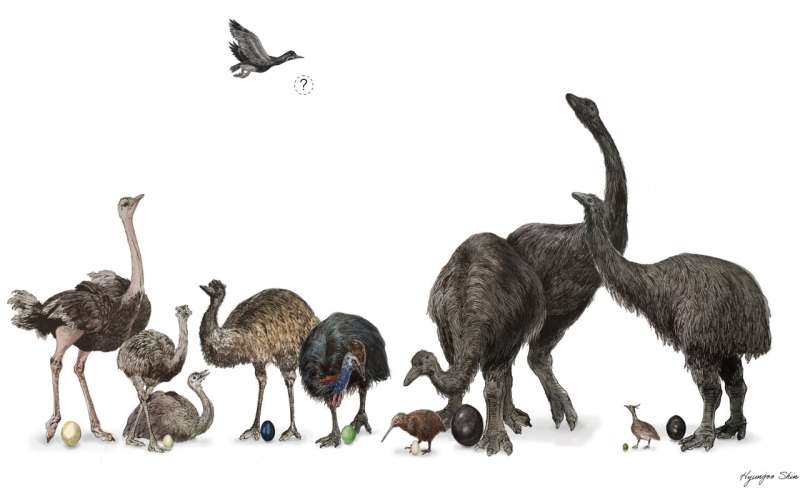Image showing flightless or poorly-flighted modern, and recently extinct, Palaeognathae with their respective egg sizes. Lithornis, an ancient flying Palaeognathae, is depicted and has an unknown egg size. Credit: Hyunjoo Shin
Molecular analysis of the eggshell structure of large flightless birds such as ostriches and emus provides new insights into how they evolved.
The study, published today in eLife, demonstrates that structural molecular analysis may complement other tools including genetic analysis in accurately tracing a group of animals' evolutionary history. The insights from the study may also aid research on the evolution of egg-laying dinosaurs.
Genetic analyses have recently allowed scientists to rewrite the evolutionary tree of the paleognathae—a class of birds that excel in running rather than flying. Previous family trees have focused on the physical characteristics of paleognaths, such as those of emus, ostriches, and rhea. But the new genetic information paired with other modern tools may provide even more information about how and why these creatures evolved their unique characteristics.
"We wanted to know if the three types of eggshells seen in paleognaths were inherited from a common ancestor or evolved independently," says lead author Seung Choi, a postdoctoral researcher in the Department of Earth Sciences at Montana State University in Bozeman, US.
Choi and colleagues used X-ray crystallography to analyze the microstructure of eggshells from modern paleognath birds, including the ostrich, rhea, emu, cassowary, kiwi, elephant bird, and two types of moa. They also analyzed the structure of fossilized eggshells from this group of birds and a selection of fossilized eggs from bird-like dinosaurs. They compared them with the eggshells of a few modern flighted birds, including the common pheasant, northern goshawk, European green woodpecker, Japanese quail, and common murre.
The analysis revealed that the wedge-like microstructures that characterize rhea eggshells trace back to ancient ancestors of paleognath birds. However, the prism-like microstructures of ostrich and tinamous eggs likely evolved independently later.
"The pattern of evolution in paleognath eggshells we revealed may help ornithologists decipher the trajectory of eggshell evolution among this group of flightless birds," Choi says.
The new information and techniques used in the study may also help paleontologists studying bird-like, egg-laying dinosaurs that lived in the Mesozoic era. Because the thick eggshells of paleognaths are also frequently found among the remnants of ancient human settlements, they may also provide helpful information to archaeologists studying how ancient humans used the eggs for food and their tough eggshells for art or other purposes.
"Genetic and microstructural analysis of these living fossils' eggshells may provide new insights on the evolution of birds and dinosaurs," says senior author David Varricchio, professor of paleobiology at Montana State University. "It may also help us better understand how early humans lived and interacted with these fascinating creatures."
More information: Seung Choi et al, Microstructural and crystallographic evolution of palaeognath (Aves) eggshells, eLife (2023). DOI: 10.7554/eLife.81092
Journal information: eLife
Provided by eLife
























